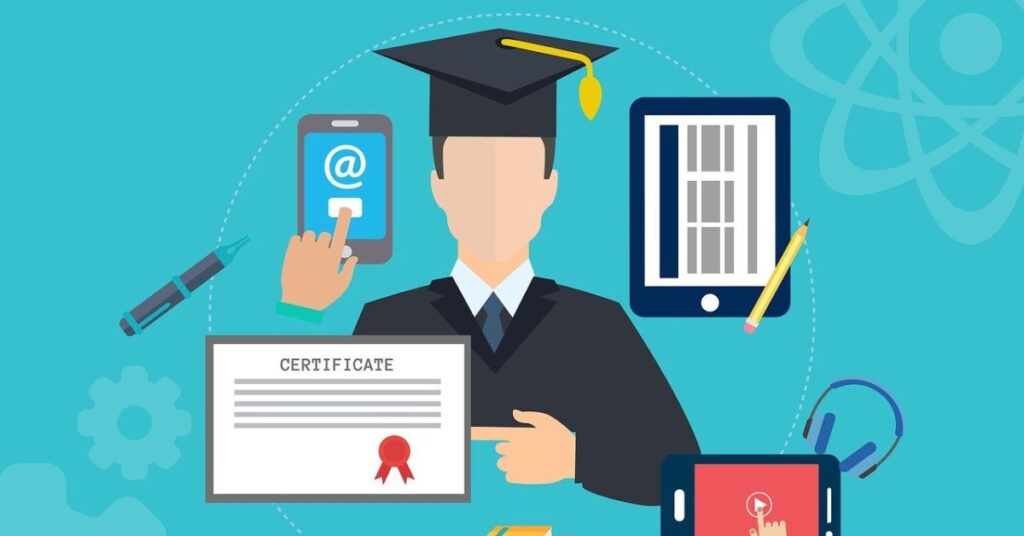Introduction
In today’s education, technology in education plays an important role. It allows for online education, distance learning, and access to current information. Technology in education enables students to assist one another and collaborate across disciplines to better understand the material. Every day, the importance of technology in education grows.
Revolutionizing the Learning Landscape
Growing digital technology in education has revolutionized the learning landscape. With interactive digital tools, online platforms, and virtual classrooms, students now have access to a wealth of resources and personalized learning experiences. Technology in education enables remote learning, breaking down geographical barriers and fostering global collaboration. It enhances engagement through gamification and interactive content.
Adaptive Learning and Data-Driven Insights
Adaptive learning platforms cater to individual learning styles, promoting better understanding and retention. Moreover, data analytics provide valuable insights into student performance, allowing educators to tailor instruction accordingly. Embracing technology in education empowers learners, facilitates lifelong learning, and prepares them to thrive in a rapidly evolving, tech-driven world.
Transforming Traditional Learning Methods
Technology in education is altering traditional learning methods and improving the overall learning experience. It encourages participation and interactivity while catering to a variety of learning styles. Students can expand and deepen their knowledge beyond textbooks with access to huge online resources.
Enhancing Collaboration and Workforce Preparation
Collaborative tools improve communication and teamwork, equipping students for today’s workforce. Furthermore, adaptive learning platforms customize training, meeting individual needs and improving academic success. Immersive experiences are provided by virtual simulations and augmented reality, making complex subjects more accessible.
Advancing Teaching Approaches
As technology in education advances, it enables educators to implement creative teaching approaches and equips students with critical digital skills, which are required for success in today’s fast-paced, technology-driven world. The contribution of technology in education lies in fostering innovation and creativity.
Educational Technology in Practice
We are surrounded by technology in education. Many new technologies are being used in classrooms today. It is used for social networking, podcasting, interactive whiteboards, mobile devices, and online live classes. The use of computer hardware, software, and educational technology theory and practice to support learning is referred to as educational technology.
Advantages of Technology in Education

Increased Collaboration and Communication
Technology in education can assist teachers in engaging students. Students can communicate with one another. It leads to collaborative activities where students can share their thoughts and ideas about their lessons. Students will be connected to complete their tasks through technology-based activities. Students who are more technologically advanced can assist their less experienced peers.
Personalized Learning Opportunities
Technology in education facilitates personalized learning. It enables online education via laptops or mobile devices. Students can study at their own pace at any time. Teachers can design lessons based on their students’ interests. Students can view lesson-related videos. Teachers can assess students’ progress using a variety of online tools, showcasing the benefits of technology in education.
Incorporates Different Learning Styles
Technology in education can assist us in revising our lessons. Each child in our classroom is unique, and it can be difficult to tailor our lesson plan to each individual. Students have various learning styles and abilities. Technology in education offers numerous opportunities to make learning more effective for people with varying needs. Digital technology in education has the potential to expand opportunities for struggling or disabled students. The Internet provides students with a wide range of resources to conduct research in various ways, which can increase engagement.
Improves Knowledge Retention
Students who are engaged and interested in what they are studying are expected to retain more knowledge. Technology in education can assist in encouraging active participation in the classroom, which is also an important factor in increasing knowledge retention. Different types of technology in education examples can be used to produce the best results for students in terms of knowledge retention.
Technology in Education Debate: Pros and Cons

The pros and cons of technology in education are a topic of frequent debate. While the advantages of technology in education are numerous, such as improving collaboration and personalization, there are also disadvantages of technology in education, including over-reliance on gadgets and potential distractions.
Technology in Education in India
In India, technology in education is playing a transformative role, bridging gaps in rural and urban education, and providing access to global resources. Technology in education in India has the potential to revolutionize classrooms and enhance learning experiences.
Conclusion
The role of technology in education is undeniable. From improving collaboration to fostering lifelong learning, the use of technology in education demonstrates its transformative power. By addressing its challenges and leveraging digital technology in education effectively, we can unlock its full potential for students, teachers, and society at large.
You may like to read:-
UNESCO Report: The Impact of Climate Change on Education
What Makes a Great School Principal?
- How to Dominate Your Online Business With 5 Proven Digital Marketing Strategies
- How to Cultivate Critical Thinking and Problem-Solving Skills in Classroom
- Top Proven Mental Health Strategies for Schools in 2025-26
- Time Management for Teachers: How to Plan, Prioritize, and Perform Better
- How Parental Involvement in Education Shapes a Child’s Growth and Success
Frequently Asked Questions
1. What is the role of technology in education?
Today, technology has a very significant place in education. It supports education through distance learning and helps gain access large amount of current information. When working with learners in groups, fosters interdisciplinary learning since students gain an improved perspective of the content they are studying. Technology also puts no bounds on geography, encourages students of the world and provides them with the tools to survive the future world.
2. What are the advantages of technology in education?ZxTechnology brings many benefits to education. It fosters teamwork and interaction since it provides the students and teachers means to communicate. LK is more effective in handling each student because learning experiences are tailor-fitted according to their learning profiles’ strengths and weaknesses. Technology caters for all students with learning difficulties by allowing disabled students to access materials that may be hard for them to read among other things. It also enhances knowledge retention via fun inventive tools while complex topics such as art are better taught using augmented reality.
3. How does technology enhance personalized learning?
Essentially, the three areas of learning seeking a boost through technology are greatly enhanced by personal learning. It also enables students to learn at their own pace and convenience they may be using a laptop or even a mobile phone. Teachers need to be able to adapt to lesson plans for students; learner outcomes can be monitored through an adaptive learning application. When customized to the learner’s style and requirements, modern technology guarantees that students get proper teaching, which in return will make them yield better results.
4. What are some examples of technology used in education?
Education has adopted many technological gadgets to improve learning activities as can be seen below. These include digital collaborative interfaces such as full touch screen end-user devices inclusive of smart boards and games, virtual classrooms, especially amid the current COVID-19 situation and knowledge sharing through pod-casting among others. LinkedIn promotes group collaboration while augmented and virtual realities apply comprehensive approaches to teaching that simplifies issues for students.
5. What are the pros and cons of technology in education?
The integration of IT in learning processes has advantages and disadvantages. On the upside, it strengthens involvement, fosters cooperation and grants a possibility to access global materials and remote interactions. It also tends to different learning styles as well as enhances the grasping capability of the students. However, there are disadvantages: for example, children may become dependent on devices, or there may be a gap in using technology among the districts and schools based on the poverty level. Another issue experienced by teachers in integrating effective technologies into teaching is how to implement those into traditional classroom approaches.



